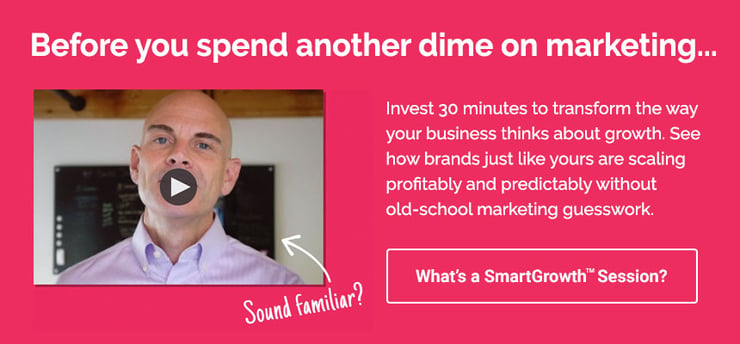At first glance, a comparison between demand generation vs. lead generation seems like a juxtaposition of new vs. old. You’ve got “demand gen” – one of the hottest B2B marketing trends. And “lead generation” – a practice popularized in old-school marketing books from 1950’s-era gurus.
To characterize these concepts as such, however, is selling them both short.
In modern B2B marketing, both approaches are essential to a complete B2B online marketing strategy. But it’s important to understand why.
In this article, we’ll clearly define demand gen and lead gen. We’ll look at the skills required for both. And, we’ll answer important questions that every B2B should be asking:
- What is the difference between lead generation and demand generation?
- Is demand generation or lead generation better for B2B marketing?
- At the end of the day, how can you find the best B2B marketing agency?
You’ll be ready to put the right strategy and the right team to work, so you can eliminate guesswork from your marketing efforts. But first, let’s start with the basics...
What is B2B Demand Generation?
Demand generation in B2B refers to marketing activities designed to build awareness and trust. Typically focused on the early stages of the buyer journey, B2B demand generation campaigns target a company’s ideal customer before they are actively seeking a solution.
The ultimate goal of the demand generation framework is to win buyers over before they even reach out to sales. Producing and promoting thought leadership content through paid and organic channels is the core strategy of demand generation B2B marketing.
B2B demand generation tactics can be applied to other stages of a customer acquisition funnel as well. This is where the line begins to blur with B2B lead generation, and growth marketing vs. demand generation.
Companies looking to incorporate demand generation strategies into their marketing programs often turn to a demand marketing agency, demand generation marketing agency, or B2B content marketing agency for help.
What is B2B Lead Generation?
B2B lead generation is the process of identifying, attracting and engaging a targeted audience, with the intent of a sale. Most often, the goal of a B2B lead generation funnel is to convert strangers into known marketing contacts. Once in a company’s marketing database or CRM, leads can be “nurtured” with follow up communications designed to move them closer to a purchase decision.
B2B lead generation tactics include “gated” content resources, like ebooks and whitepapers, that can be downloaded in exchange for a prospect’s contact information. Other tactics for initiating 1:1 communication with potential buyers include webinar registrations, online quizzes, free trials, email marketing, and live events.
With so many options, companies often turn to outsourced B2B lead generation services for help. B2B lead generation agencies and other B2B lead generation specialists can be a good fit for companies in need of “hot” leads to satisfy short-term sales goals.
In contrast, hiring a growth marketing agency will put the focus on building sustainable lead generation that drives consistent revenue growth quarter over quarter.
Demand Generation vs. Lead Generation: What’s the Difference?
Demand generation tactics put authoritative content in front of potential buyers with the goal of educating them, earning their trust, and spurring a purchase decision – without the pushing and prodding of salespeople. Ultimately, successful demand gen leads to buyers seeking out a solution by name and taking action.
Lead generation, on the other hand, aims to gather contact information from a large pool of potential buyers and establish 1:1 communication with each of them. In B2B lead generation, this often involves automated email nurtures and outreach from a sales development rep (SDR).
Lead and demand generation objectives both concentrate on attracting potential buyers and converting them into customers. Demand generation does it from afar, arming buyers with the content they need through B2B marketing channels, so they can make informed decisions on their own. Lead generation pulls buyers into 1:1 communication with a B2B, so companies can directly influence the decision-making process.
Which is Better for B2B Marketing: Demand Generation vs. Lead Generation?
In a B2B sales and marketing funnel, demand gen and lead gen work together. It’s not about choosing one over the other. Here’s why:
With complex B2B sales, involving multiple stakeholders and long sales cycles, buyers conduct research online before contacting a company for information. Both demand generation and lead generation work to attract buyers during this research phase.
Once a demand generation strategy has successfully stimulated a buyer’s interest, they’ll head to a company’s website for a closer look. Most buyers won’t be ready to contact sales yet, so lead generation strategy takes over.
A resource download, a blog signup, a webinar registration … These and other lead generation tactics provide a logical next step on a website. Any of these options will establish a 1:1 communication channel with a buyer by requesting their contact information. They are now a “lead,” that can be nurtured until they are ready to contact sales.
Lead generation on a B2B website is just the tip of the iceberg. Successful demand generation can prime potential buyers to volunteer their contact information through social media, email, live events and many other channels.
The key is to remember that modern buyers will contact a company for help with its products or services when they are good and ready. Until then, educating them, earning their trust, and staying top of mind are essential.
The best way to do that, is to have the right demand generation and lead generation skills across your team. Whether you’re tackling it all in-house, or looking to outsource marketing, it helps to understand what kinds of specialists exist, and how agencies approach B2B marketing team structure and demand generation team structure.
B2B Demand Generation Agencies
Complex strategies and constantly evolving technology are just a few reasons why a B2B company might hire a demand generation marketing agency. Outsourced demand generation is a cost-effective way to gain access to multiple areas of expertise quickly and efficiently.
Generating demand through multiple channels requires a team with proven skills in organic search, paid advertising, analytics, content creation, inbound marketing strategy and more. While a demand generation consultant or an in-house team often seem like budget-friendly options, many B2Bs will find more value engaging a team of experts on a fractional basis.
Typical roles in a demand marketing agency are:
- Director of Demand Generation
- Paid ads / PPC specialist
- Search Engine Optimization (SEO) strategist
- Content marketer
- Conversion Rate Optimization (CRO) specialist
- Social media manager
B2B Lead Generation Agencies
Where demand generation agencies tend to offer a broader range of B2B marketing services, lead generation agencies have a narrower focus. Some may rely more on organic lead generation, while others will focus on paid channels. There are even lead generation companies that sell lists of “qualified” leads.
Growth-minded B2B companies will want to concentrate lead generation efforts on organic strategies. Paid channels and purchased leads can contribute to short-term sales, but both come at the expense of building a sustainable flow of interest through search engine traffic and brand awareness. As soon as a B2B stops paying for leads, the leads stop coming. Organic lead generation will continue to build over time.
The Key: A Smart Growth Marketing Framework
For growth-minded B2B companies, demand generation and lead generation can both play a significant role in marketing strategy. But winning at those activities alone doesn’t guarantee profitable growth. Scaling successfully requires a complete strategy that spans the entire customer acquisition pipeline—from the right messaging foundation, all the way through the sales process, and into customer retention and referral efforts.
A smart growth marketing framework will begin by defining revenue goals and building a clear roadmap to achieving them. It will prioritize marketing activities and channels, with a step-by-step approach that ensures progress instead of guesswork. It will rely on data to inform every strategic decision, set quarterly growth goals, and track results continuously.
So, consider the big picture before you hire a B2B marketing firm or a B2B marketing consultant, or before you commit to building an in-house demand generation team or investing in lead generation services.
The best growth marketing agencies will walk you through short-term and long-term strategy to reach or exceed revenue goals in a specific time frame, and will take a broader view of your business, to ensure you’re investing in growth—not just one part of the customer acquisition process.
Whether you’re ready to take the first step or just have questions, a no-pressureSmartGrowth Session with Brand Theory is a great next move. Get a free growth game plan tailored to your business goals in just 30 minutes, and learn how to stop wasting time and money on marketing that doesn’t move the needle.





.png)
.png)
.png)